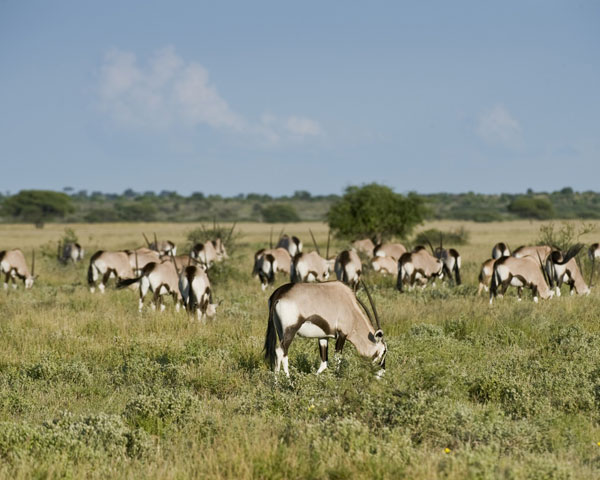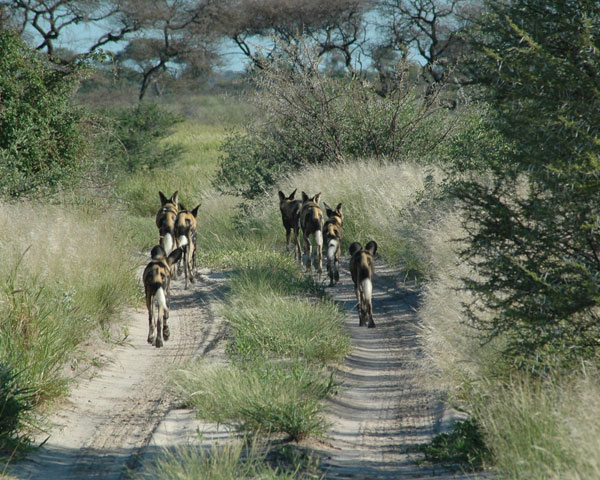An eternally flat tract of sand doused intermittently with struggling shrubbery and thirsty grasslands; the image of the Central Kalahari in Botswana is one of wandering desert plains. In all its glory, this is the second largest game reserve on earth. The Kalahari Desert in its entirety stretches from northern South Africa, into Namibia, skims Angola’s southern boundary and consumes a large portion of Botswana before enticing small parts of Zimbabwe and Zambia. The primary area of focus for game watchers and safari die-hards is in the heart of this sandy expanse in Botswana.
During the dry season from May to October, it is winter in the Central Kalahari and the desert dunes are dry and dusty. Without sufficient resources usually found at Deception Pan, spectacular predators like the lion, wild dog and leopard migrate in search of nourishment and comfort. Relief is provided at pumped waterholes in the Haina Kalahari Reserve, adjacent to the Central Kalahari. While the desert kings wet thirsty throats in the neighbouring reserve, the harsh beauty of an abandoned desert becomes an attraction of its own. The remoteness of the Central Kalahari introduces both fear and curiosity in travellers of varying ambition. Photographers marvel at incredible skies that reflect the stark land, painting perfect pictures of suede coloured horizons and sharp acacia accents. This is a time of splendour on its own, yet it is the antithesis of what awaits in the months of summer, the months of rain.

The first three months bring about the most rain the Central Kalahari will see all year, which, in fact, is not very much. After the dead heat of October, once the sun has sucked the last drop of liquid out of the scorched earth, the clouds proclaim their satiation and return in heavy, drenching downpours, the waters they have stolen from the land for so very many months. Short yet frequent, the Central Kalahari is blessed with thunderstorms and rainshowers that moisten the hardened surface, preparing them for growth and rebirth. During this wet season, a desert contrast is created as short, green grasses sweeten the earth and a lush softness spreads over the rolling landscape, decorating bare branches with vibrant leaves and filling crystallised pans with liquid life. This phenomenal celebration of nature is known as the Green Season, and Botswana becomes home to the world’s only Green Desert.

Temperatures remain high during both night and day and there in tangible moisture in the air, yet the rains that bore the widespread greenery are surprisingly scarce, while the sunshine remains dominant during February and March, allowing only a few hours of darkness each day. These conditions can be harsh and shouldn’t be underestimated, but with a well thought out approach, the experience of the Green Desert will soon secure its place at the forefront of one’s memories, photo albums and mental notes of inspiration. Aside from the spectacular transformation that only a short period of rainfall can achieve for such a determinedly arid land, this contrast of landscape invites the migration of an almighty number of birds and wildlife.
Gemsbok, springbok and wildebeest emerge from their dry season dens, many hailing from the marshes of the Okavango delta which has loyally fed and watered animals seeking refuge from the desert during the winter months. With bursting bellies, ready mothers in the thousands flock to the lush lands of the Green Desert to birth their foals where they can rely on the comfortable climate and more than enough nourishment for their newborns. This is a sight all of its own; an astounding number of antelope and their young migrating across the expanse of the largest desert in the world, as it boasts blooming plains as though it is not a desert at all.
Of course, as the scent of the rain and the wetness of the earth coaxes mass movements of grazers and browsers, so the sound of ambling hooves tantalises the senses of Africa’s carnivorous species. The impossibly frequent interactions between predator and prey depict what gives this remarkable game reserve its reputation. The great kings of the Kalahari shake their uniquely black manes and send forcefully resonant grunts into the atmosphere as they lead their prides through the desert, reclaiming their territory. Leopards, in their majesty, slink with subtle purpose; their spotted pelts can be seen poised amongst the leaves of trees, sharp eyes drinking in the welcome surroundings. Hyenas sing their eerie song as they step out at night, sure to be treated to freshly abandoned carcasses, yet not afraid to fight for the meal, should the original killer still be standing guard. Cheetahs and wild dogs, endangered species, commute from their wintertime hideaways and as they too are tempted to test the Green Desert waters and snatch up the easy meals that are presented to them in sheer abundance.

This almost theatrical performance paves the way to the perfect safari experience in one of the most renowned deserts in the world. The Kalahari’s harsh winter aridity deters even the most resilient members of the wild, for fear of starvation. Yet, after the deathly heat of the year’s last months, a transformation takes place that converts the cracked desert floor into green grassland, which produces Botswana’s most prestigious game viewing environment. The Green Desert will inspire the senses and mould perspectives while the work of nature continues to astound travellers lucky enough to share in its wonder.
To witness the spectacle of a Green Desert, we recommend relaxing in the luxury tented accommodation at Haina Kalahari Lodge, situated perfectly on the border of the Central Kalahari Game Reserve. Guests are guaranteed to embrace Africa with the natural wooden decking, soft lantern lighting and permanent canvas tents. Alternatively, Kalahari Plains Camp, situated in the Game Reserve itself, sleeps its guests in canvas tents raised on wooden platforms, providing individual viewing decks and the option to sleep under the Kalahari sky.
Chloe Cooper



